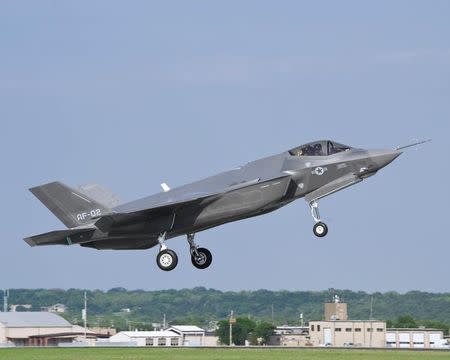U.S. Navy maintains grounding order for F-35 fighter jets

By Andrea Shalal RAF FAIRFORD England (Reuters) - The U.S. Navy on Friday maintained a grounding order for F-35 B-model and C-model fighter jets built by Lockheed Martin Corp, saying it was still not clear what caused a massive engine failure on an Air Force F-35 jet on June 23. "At this time, I do not have sufficient information to return the F-35B and F-35C fleet to flight," Vice Admiral David Dunaway, who heads the Navy's Air Systems Command, said in an update to a fleetwide grounding order issued by U.S. officials on July 3. A copy of the document was obtained by Reuters. Dunaway said in the document that he was committed to returning the F-35 fleet to flight as soon as possible, but there was "no discernible event that represents a root cause." In the incident last month, the Pratt & Whitney engine on an Air Force F-35 A-model jet broke apart and caught fire while a pilot was preparing to take off from Eglin Air Force Base in Florida air base. Until the grounding is lifted, the U.S. Marine Corps and Britain will not be able to ferry four F-35B aircraft to Britain for the fighter jet's planned international debut at two air shows there this month - the Royal International Air Tattoo, world's largest military air show that began Friday, and the Farnborough air show, which starts on Monday and runs through July 20. It would be a huge embarrassment to the United States if the jets are unable to appear at either air show, and could jeopardize export prospects for the new radar-evading plane just as two initial partners on the program - Canada and Denmark - are weighing fresh orders. The engine failure had also prevented the F-35 from making an appearance at the July 4 naming ceremony for Britain's new aircraft carrier. Dunaway said the Navy and other services are continuing to investigate the incident, and planned to update the flight directive no later than July 16 - two days after the start of the high-profile Farnborough air show outside London. Dunaway's memorandum did not rule out the possibility that the most advanced U.S. fighter jet could still appear at the tail end of the Farnborough air show, but the prospects of that occurring appeared to be dimming fast. "There are specific additional evaluation conditions required to support the Farnborough air show in the UK, including the ferry flight across the Atlantic and performance in the airshow itself. Additional work is required in order to understand and mitigate airshow unique risks," it said. Four Marine Corps F-35B jets are waiting to fly across the Atlantic at a Maryland air base, and a UK jet that had been due to join them remains at Eglin Air Force Base in Florida. The U.S. jets were qualified and ready to fly as soon as the grounding order was rescinded, said one person familiar with the situation. Dunaway said the current analysis would have to be refocused to potentially meet the timeline for the F-35's participation in the Farnborough air show. The jets need a full day in Britain to allow for any maintenance or repairs before they participate in flying demonstrations. Dunaway said officials were looking at possible operational restrictions for the jets while the issue was still being investigated, and would also likely implement recurring engine inspections to monitor for any indication of a future problem. But those measures would take several more days to complete. It remains unclear what caused the third stage of the Pratt engine to break apart and burst through the top of the airplane. The incident severed a fuel line, which then caused a fire. Frank Kendall, the Pentagon's chief weapons buyer, told U.S. lawmakers on Thursday there was "growing evidence" that the incident was an individual event and had not been caused by a systemic issue. He said all existing engines had been inspected and that no issues similar to the one that caused the engine failure had been found, but he said safety was the Defense Department's top priority. (Editing by Sandra Maler and Ken Wills)

